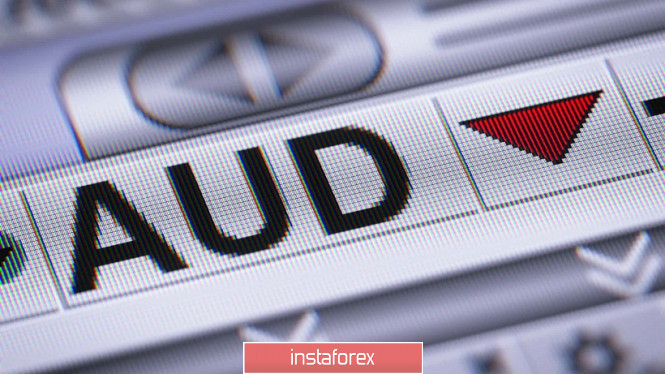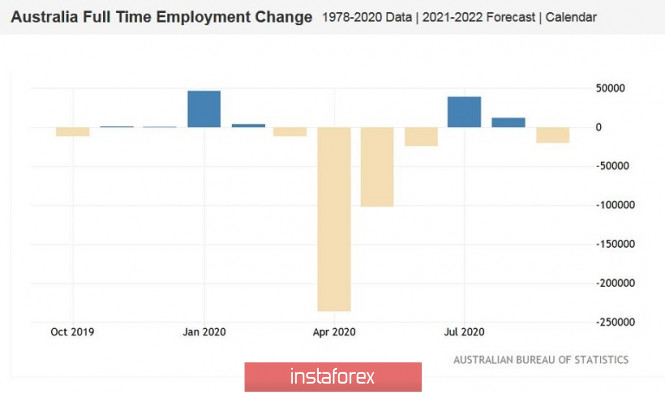
The Australian dollar was not supported by macroeconomic reports. Data on the Australian labor market, although slightly better than expected, still reflected a slowdown in the recovery process in the country. The "test shot" for the Aussie was a speech by RBA Governor Philip Lowe, which took place against the backdrop of the Chinese indicators' disappointing release. Such fundamentals have reignited speculation that the Reserve Bank of Australia may cut interest rates at the next meeting.
In the Australian statistics, the preliminary forecasts did not bode well. According to most experts, the unemployment rate was expected to rise to 7.2%, and the growth rate of the number of employed was expected to decrease by almost 40 thousand. The figures were slightly better in reality than the forecast: unemployment rose to 6.9%, but the number of employed people decreased by 29 thousand. However, we should not pay any heed to the fact that the announcement was released in the "green zone." As a matter of fact, this situation is clearly negative and there is no reason for optimism here.

The unemployment rate is gradually rising again, despite the fact that a decline was recorded in August after a four-month marathon. For comparison: in the "pre-crisis" times, this indicator fluctuated in the range of 5.0%-5.3% for many months. Starting in April, unemployment starts to rise and reaches its peak (7.5%) in July. In August, there was a fairly sharp decline (6.8%), after which there were hopes for a relatively rapid recovery in the Australian labor market. However, the September data showed that it is too early to talk about the recovery of key indicators.
The employment growth rate also reflected worrying trends. First, this indicator declined for the first time since May of this year (when the country was just coming out of full lockdown mode). Second, this decrease was mainly due to a reduction in the full employment component. If the indicator of partial employment growth decreased by 9 thousand, the indicator of full employment went into negative territory by 20 thousand. Recall that the RBA reports have repeatedly indicated that full-time positions tend to offer a higher level of salary and a higher level of social security, compared to temporary part-time jobs, resulting in the decline in consumer activity of Australians and weak inflation growth. Therefore, the current dynamics are doubtful to please the members of the Australian regulator.
The published Chinese data during the Asian session on Thursday exerted additional pressure on the Aussie. Despite the difficult political relations between Canberra and Beijing, China is still Australia's largest trading partner. Thus, the slowdown in the Chinese economy is also reflected in the Australian's well-being. According to published data, the consumer price index in China (in annual terms) in September increased by only 1.7%. This is the weakest growth rate since March last year. At the same time, this indicator increased by 2.4% in the previous month. The producer price index, which is an early signal of changes in inflationary trends, was also disappointing. This indicator, firstly, remained in the negative area, and secondly, was in the "red zone," falling short of the weak forecast values (-2.1% instead of -1.9%).
It is not surprising that the Australian dollar weakened throughout the market against the backdrop of such a fundamental picture. In early October, there were rumors on the market that the Australian central bank will soon reduce the interest rate. This scenario was warned by currency strategists at the country's largest financial conglomerate Westpac, whose position was also supported by AMP Capital, HSBC, and UBS. Economists at these banks predicted a rate cut before the end of this year as "one of the most likely options."
However, at the October meeting, RBA members restricted themselves to saying that the regulator "continues to consider how additional monetary easing can support the growth of the labor market as the economy continues to recover." In other words, the Australian regulator did not rule out the option of easing monetary policy, but it did so in a rather veiled way, ergo the Aussie ignored this message at the end of the October meeting.

But this signal from the RBA today played with new colors. A few hours before today's release, the head of the Australian Central Bank, Philip Lowe, said that he does not exclude a further reduction in the interest rate to 0.1% (that is, by 15 basis points). However, he ruled out raising the rate for "at least three years." Given these messages, we can conclude that the regulator will still consider easing monetary policy at the November meeting (November 3).
Therefore, the dovish rhetoric of the RBA head, the failed data on the labor market, the latest restrictions from China (a ban on the import of Australian coal), and the decline in Chinese inflation suggest that the Australian dollar will soon be under significant pressure.
The AUD/USD pair is currently testing the support level of 0.7130 – this is the lower limit of the Kumo cloud on the daily chart. With a high degree of probability, we can assume that the bears will push through this level and go to the main price citadel – to the "round" mark of 0.7000. Given the fundamental background that has developed for the Australian dollar, short positions to the base of the 70th figure are in priority for the pair.